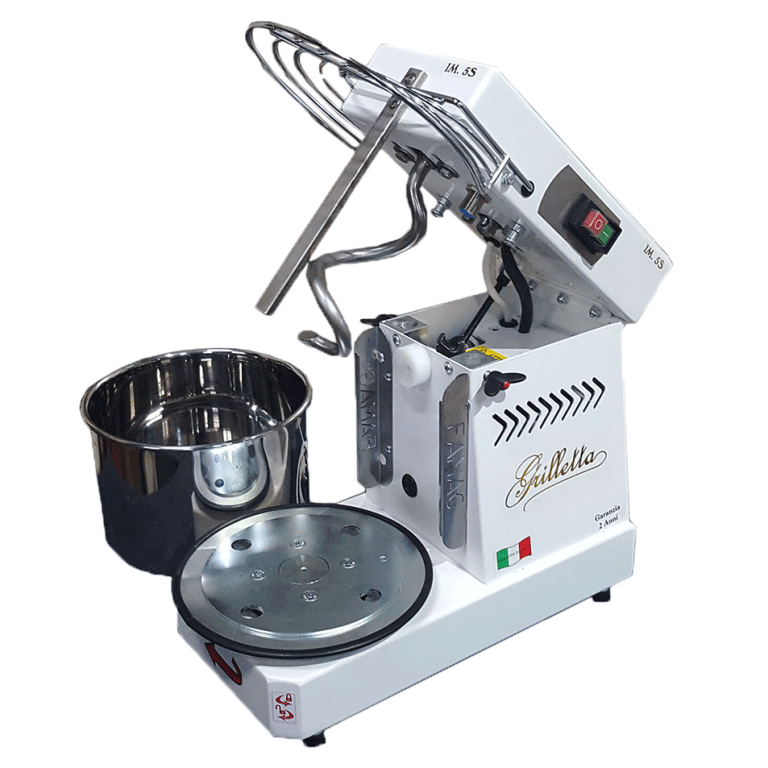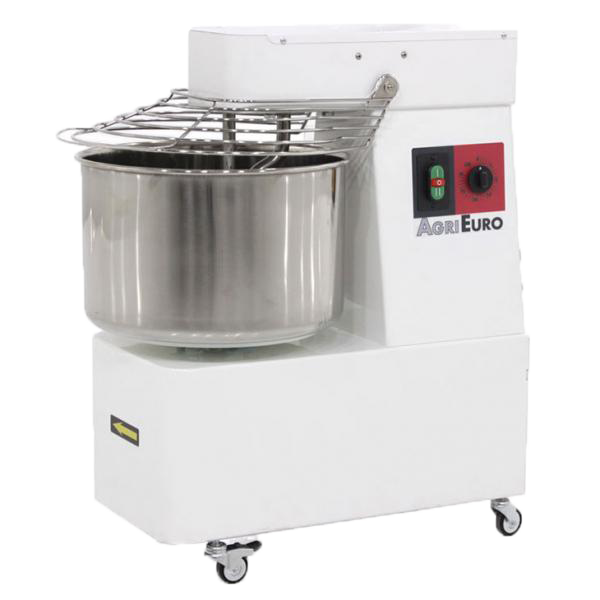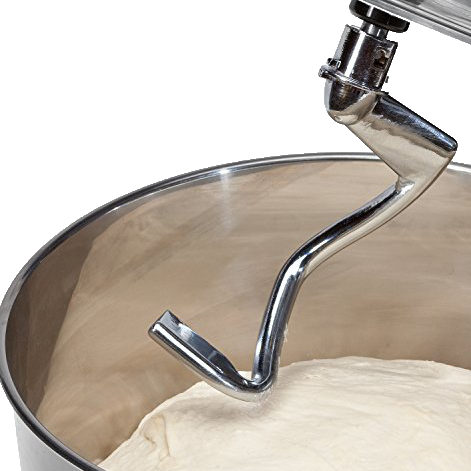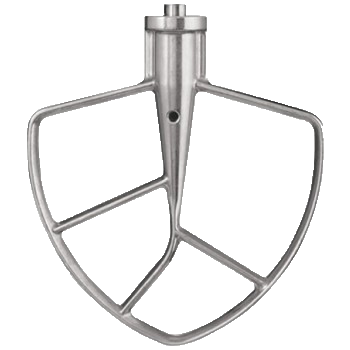The Complete Guide to help you choose the Best Spiral Mixer
by the Real Experts of Kitchen Equipment
Today, the dough mixer is no longer an exclusive appliance of professional kitchens and workshops, but has become extremely widespread, thanks above all to the marketing and diffusion of smaller, low-cost machines within the reach of the domestic user.
It has therefore now entered the kitchens of most people as an indispensable tool, certainly in the kitchens of those who are passionate about good cuisine, healthy food and the home preparation of rich and tasty dishes.
Before going into the subject, it is necessary to make a preliminary remark.
There are two main types of dough mixers on the market:
- planetary mixers
- spiral mixers
The most significant difference between the two types lies in the fact that the planetary mixer is mainly suitable for soft dough, whereas the spiral mixer is also specific for hard dough.
This purchasing guide deals almost entirely with the second type: spiral mixers.
CONTENTS
1. Spiral mixer – Description and key features
In order to understand how to choose the best spiral mixer, let’s see what the main characteristics are:
This type of dough mixers were created to be used in professional environments (pastry shops, bakeries, pizza restaurants, etc.) but thanks to the marketing of smaller, less professional versions, they are now also entering domestic kitchens.
As we already mentioned above, spiral mixers, compared to planetary ones, are more specific for hard dough, which are intended for bread-making, pizza restaurants, pastries, etc.
This difference of use is basically related to 5 elements:
- The large spiral
- The large capacity and strength of the bowl
- The breaker bar
- The double rotation (of both the spiral and the bowl)
- The sturdy mechanical structure
The large spiral
These spiral mixers do not have as wide a variety of uses as planetary mixers, because their tool – the spiral – is fixed and not interchangeable with other different tools for different applications. This makes the spiral mixer suitable for only one specific usage.
The large capacity and strength of the bowl
Made of high thickness stainless steel, it has the classic shape of a pot and therefore does not have a conical circular wall towards the bottom part. This perfect cylindrical pot-like shape is closely related to the position of the spiral, which is not at the centre of the bowl (like the tools of planetary mixers, in which the bowl is fixed), but shifted to one side. It is the rotation of the bowl that cyclically brings all the dough under the kneading action of the rotating spiral.
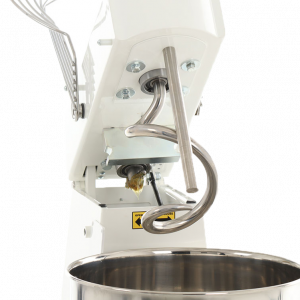
The breaker bar
Placed vertically next to the spiral in the centre of the bowl, allows for a more efficient kneading function of the spiral by preventing its rotation from dragging the entire mass of dough behind it.
The double rotation
This is one of the most notable features of spiral mixers, making them exceptional in terms of dough quality. In these machines, there is not just a single rotation of the centrally positioned tool (like planetary mixers), but also a rotation of the spiral (off-centre) plus the rotation of the bowl (which obviously has a lower rotation speed).
The sturdy mechanical structure
It is no coincidence that the weight of a spiral mixer can be up to 2 or 3 times greater than that of a planetary mixer. It is a structure designed to withstand heavy workloads involved in mixing hard dough, even for non-stop processing that last several hours.
2. Spiral mixers – Classification and dimensions
Before moving forward with the purchase, whether for a domestic or a professional use, there are many factors to consider in assessing the best dough mixer.
First of all, the dough capacity, that is the maximum quantity, expressed in kilos, of final dough that can be obtained with the specific bowl fitted to the machine.

It is precisely on the basis of their dough capacity that, for illustrative purposes, we classify them into:
Before going into detail, we would like to specify that the units of measurement used to define the size and capacity of a spiral mixer are kilograms (kg) or litres (L or lt).
Both are commonly used, either by manufacturers and by vendors or end users. Perhaps the most widely used of the two is kilograms (kg), as this probably best expresses the “size” or “quantity” of the dough, which is in any case a solid rather than a liquid matter (although soft and malleable). Therefore, expressing the achievable capacity of each spiral mixer in “kg of dough” is certainly the most correct and understandable approach for the user.
Please note that the definition in litres is generally higher than the definition in kilos by about 15/20% (e.g. an 18 kg mixer has a capacity of 22 litres).
Therefore, from now on, we will define spiral mixers using only kg as the unit of measurement.
2.1 Small spiral mixers (5-10 kg)
Small spiral mixers have a dough capacity of 5 to 10 kg. Even if most of these are classified as hobby level, they are nevertheless capable of achieving excellent final results: in fact, as they are always equipped with a double rotation (bowl + spiral), what sets them apart from those of a higher level is mainly the size of the bowl, and therefore the effective dough production capacity.
But as for the quality and sturdiness of the internal mechanics and the quality of the dough produced, they are not at all different from the large, professional laboratory models, being to all intents and purposes the perfect reproduction on a smaller scale of those larger machines.
Kneading machines of this size will therefore also be chosen by all those aspiring chefs who want to try their hand at the art of baking, so that they can knead and then bake bread, pizza, cakes, etc. directly at home, achieving the best possible result in terms of quality and flavour.
As mentioned above, small spiral mixers replicate the design of industrial mixers perfectly; however, although the latter have useful elements for movement such as transport wheels, they are sometimes considered a bit bulky by home users, who prefer a fixed machine to be kept in the kitchen.
To meet this need, there are now spiral mixers with very compact dimensions, which can be easily placed on the kitchen worktop and used without too much trouble for movement.
These machines have been specifically redesigned to maximise space, weight and portability, but with a mechanical and structural sturdiness that has remain unchanged. For this reason, the range of models with a dough capacity of 5 to 10 kg, includes all the spiral mixers most appreciated by end costumers.
In addition, given the ever more frequent positioning on the kitchen worktop, some manufacturers now also produce coloured variants of the smaller models, to give an extra touch of colour to the kitchen or to better blend in with its style and colours.
Also recently introduced for smaller spiral mixers are highly innovative features such as:
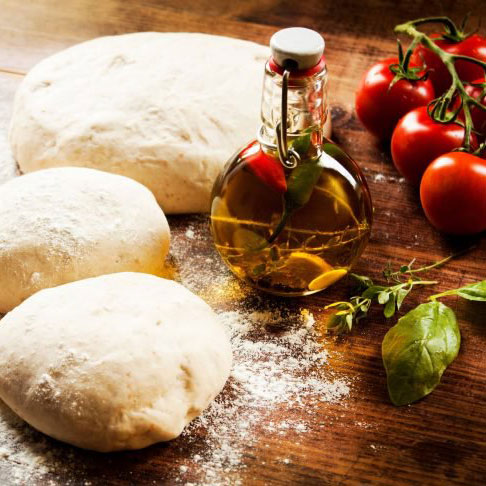
- Tilting head and removable bowl
- 2-speed operation or 10 rotation speed levels
However, we will deal with these features in more detail in dedicated sections later on this article.
Wanting to provide home users with a few references regarding the production that allows for the maximum dough capacity achievable by small mixers, i.e. 10 kg, we can say with certainty that you will be able to satisfy quite a number of guests: in fact, if we take the average size of the classic pizza, which is 220 g, we can produce up to 45 pizzas with 10 kg of finished dough.
As for the classic 20×30 baking pans, we suggest a size ranging from 350 g, if you prefer a thin pizza, to a maximum of 500 g, if you want to make a nice flatbread. With 10 kg of dough, it is possible to bake between 20 and 28 pizzas.
2.2 Medium spiral mixers (12-25 kg)
Medium spiral mixers have a dough capacity of 12 to 25 kg.
As we already made clear, this classification is not a widespread and recognised convention, but is being applied by us in order to provide guidance to all those less experienced users in the field of spiral mixers.
The models included in this range, in line with the ranges of most manufacturers, are generally of three sizes:
- 12 kg (16 Lt)
- 18 kg (22 Lt)
- 25 kg (32 Lt)
They are available with single-phase 230V or three-phase 400V power supply.
Why are they classified as medium?
Because it is a dimension particularly appreciated by certain types of end users, such as demanding housewives or families with ancient culinary traditions who retain the custom of a large production of baked sweets, or pizzas and flatbread, traditional baking products (including Panettone or hot cross buns) or even a certain amount of homemade high-hydration bread.
The second target users are small businesses or production laboratories, such as bars, restaurants, pizza restaurants, grocery shops, typical local food shops, small pastry-making businesses, etc.
Other than the size of the bowl and therefore the capacity of the dough that can be made, among the aspects that set them apart from the small-sized ones there are elements such as the timer and the pivoting wheels for movement (not always present on the small-sized models described in the previous section).
Also available for spiral mixers from 12 kg to 25 kg are the additional options (which certainly have a significant impact on the cost) consisting on the tilting head and removable bowl or the possibility of having 2 speed levels or the 10 rotation speed levels switch.
As already mentioned, the characteristics of these accessories will be dealt with in later sections.
2.3 Large spiral mixers (30-50 kg)
Large spiral mixers have a dough capacity of 35 to 50 kg.
The maximum amount of dough this class of spiral mixers can process is 50 kg and this is where the classification of these mixers reaches its maximum dough capacity level, because larger models would no longer be defined as such, but as industrial mixers, suitable for very structured and large professional activities, and we would be entering into the field of very specialised machines.
The models included in this category, in line with the ranges of most manufacturers, are generally of three sizes:
- 35 kg (40 Lt)
- 42 kg (48 Lt)
- 50 kg (54 Lt)
They are available with single-phase 230V or three-phase 400V power supply.
Machines of this level are of a professional standard: they are normally found in pizza restaurants that produce more than 150 pizzas a day and want to make the dough in one go, or in the workshops of bakers and pastry chefs. Precisely because they are used in laboratories, they are in most cases required with a three-phase power supply.
Also among these there are models with a tilting head and removable bowl or with 2 speed levels.
2.4 Conclusions on spiral mixers dimensions and recommendations on minimum dough guaranteed
In short, the dough capacity is basically the main element to take into account when deciding which spiral mixer to choose.
Our advice is never to be too limited in the choice of machine size and capacity, because once a machine has been purchased and its special features are known, its use often extends far beyond what was originally intended and you may regret not having purchased a larger machine.
But it is also useful to pay some attention to the opposite factor, known as the minimum dough guaranteed, by which we mean the minimum quantity of final dough that a dough mixer can make.
In fact, when choosing a spiral mixer, the size is chosen on the basis of the maximum amount of dough you expect to be able to knead, but you will not always be able to produce dough using the full capacity.
Furthermore, it would be a waste not to use the spiral mixer even for the simple execution of a single sweet pastry, or other small dough kneading, thus using only a small part of its capacity.
This is why the spiral mixers available today on the market are able to knead even the smallest quantities of dough thanks to their high capacity for collecting and mixing the mixture and the double rotation of the spiral and bowl.
However, we always suggest looking for this aspect in the various models of spiral mixers and taking it into account during the phase preceding the purchase.
It becomes especially relevant in the case of small spiral mixers, which can achieve a minimum dough guaranteed of 300 g. This allows the home user to knead in small quantities, e.g. to make a small baked cake or tart or a small amount of biscuits.
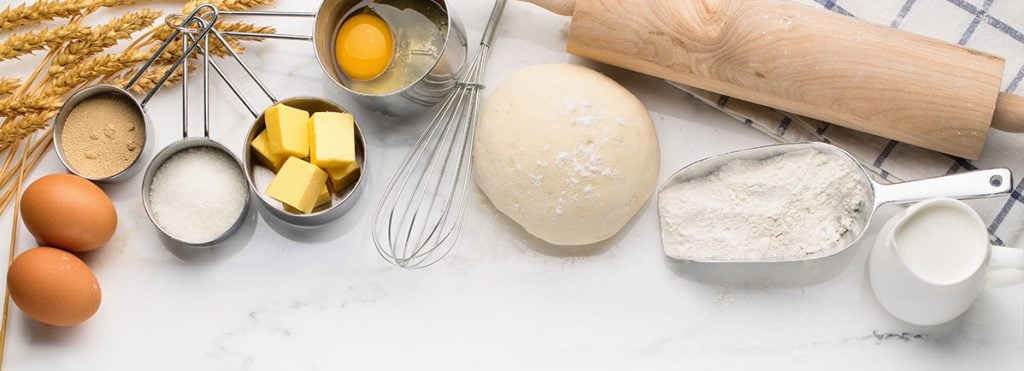
3. Equipment, accessories and new features of spiral mixers
Spiral mixers are also undergoing a continuous process of improvement by leading manufacturers, making them constantly innovating in terms of equipment, accessories and functions.
Here are the main accessories, from the more classic ones that come as standard, to the more innovative and recently introduced ones, supplied by a smaller circle of manufacturers and most of the time not as standard but at an additional cost.
3.1 The timer
As far as the timer is concerned, the spiral mixer can be used in two modes:
- manual mode, it is the user who manually starts and stops the kneading, without activating the timer;
- in “countdown” mode, where the user can set the duration of the spiral mixer’s kneading for a certain period of time, so that it will then automatically stop once the set time has elapsed.
3.2 Removable bowl and tilting head
The removable bowl and the tilting head are related features: where there is the possibility of tilting the mixer head, there will also be the possibility of removing the bowl from its base (these features are usually supplied together in the same spiral mixer).

These features offer considerable advantages, both from a hygiene and a functional point of view. Why?
- The tilting head allows a much more convenient and effective cleaning of the spiral and the breaker bar.
- The same applies to the removable bowl; this can be easily washed by hand (without the spiral and the breaker bar in between) or directly in the dishwasher.
These two aspects must be taken into consideration when kneading dough with gluten-free flours: these types of preparation leave a very sticky residue that is difficult to clean; in this respect, having the possibility of removing the bowl from the base can be very convenient and above all much more hygienic.
As far as the working process is concerned, on the other hand, the removable bowl also allows to let the dough rise in the place you prefer; in fact, if you are making an “indirect” dough (in the case of pre-dough, such as biga or poolish), simply remove the bowl from its base and move it to where you want the dough to ferment. All the other ingredients are then added to the initial pre-dough.
Many experienced cooks or pastry chefs (and sometimes even the manufacturers of the kneading machines themselves), however, claim that, in principle, there should be no need for the lifting head + removable bowl functionality as far as the washing operation is concerned, because “a well-made dough comes off the steel bowl completely and easily without leaving the slightest residue in it, thus remaining almost perfectly clean”.
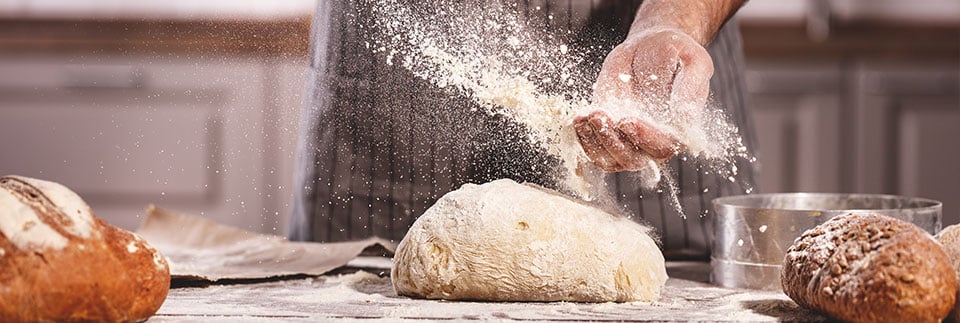
3.3 Single Speed – 2 speed levels – 10 speed levels
The number of speeds, on the other hand, allows the ingredients of the dought to be mixed gradually. For example, in the case of a basic pizza dough, first mix the flour with the yeast and water at a low speed; only when the gluten mesh begins to form the oil and the salt can be added at a higher speed. This will allow the dough to be ready in less time.
The possibility of using different speeds in the process of making dough can sometimes also require some experience with both the spiral mixer and the dough being made. For this reason we recommend all home users to use a single speed to avoid incorrect dough preparation.
The speed gauge, which allows you to reach up to 10 different levels, will be very useful for processing time issues: especially when dealing with liquid mixtures, such as whipping cream or egg whites, the fastest level will help to obtain the desired consistency in the shortest possible time.
However, it should be borne in mind that too high a speed, in the case of hard dough, such as for pizza or bread, can overheat the mixture and lead to an unsatisfactory result. This is why, as we already explained, if you have any doubts when you are making pizza dough, it is always a good idea to use only one speed.
4. Costs of a spiral mixer
Now let’s talk about the prices of spiral mixers.
We must first of all draw a distinction, as we already did at the beginning of this purchasing guide, between the prices of the planetary mixers that manufacturers produce and which start from as little as €50, given that these are very limited machines with limited structural sturdiness, and the prices of true spiral mixers which, although with reduced mixing capacity, have the same characteristics of robustness and functionality as heavy-duty spiral mixers, and which therefore start at €500.
Let’s see now in detail how the price of spiral mixers changes.
It is evident that the first element that determines the price of a kneading machine is the size and, therefore, the ultimate dough capacity that can be achieved with it.
On this basis, a minimum cost of €500 for a 5 kg kneading machine, mainly used for home preparation, increases up to €2000 for heavy-duty machines, e.g. those employed in piazza restaurants that bake more than 200 pizzas a day.
In addition to the size, the other aspects that significantly affect the final price of spiral mixers are all those elements that we have seen above, according to which the functionality and comfort of the machine can change.
First and foremost, the removable bowl and the tilting head: these aspects, which are always related to each other, can increase the price by more than €200, depending on the manufacturer of the spiral mixer.
Having 2 speed levels or a speed gauge can also add €200 to the final cost.
Finally, of lesser importance in terms of the final price, are the timer and the wheels: the increase may vary depending on the size of the bowl, but for these additional features an increase of up to €50 is possible.
5. Brief description of the planetary mixer

As already mentioned, planetary mixers are mainly recommended for making homemade cakes or at least to knead soft doughs, but this does not completely rule out their use for harder doughs, such as those for bread or pizza, as they prove to be very versatile.
In most cases, these machines are strictly intended for domestic use and are limited in terms of both frequency of use and the quantity of dough produced, as they most often feature a small/medium sized bowl.
However, they are highly appreciated for their versatility of use, being able to perform a large number of functions. Their versatility comes also from the possibility of applying different types of accessories:
- The dough hook: especially suitable for leavened dough, such as those for brioche, flatbread or panettone, and which therefore require a certain amount of energy.
- The flat beater: suitable for doughs that are not too liquid but not too hard either, e.g. shortcrust pastry or even for a meatball mixture or for making a good puree.
For baked desserts, however, it can be used for all those doughs that do not need to be whipped and are denser, such as that of muffins.
- The wire whip: specific for mixing liquid mixtures, especially when they need to be whipped, such as cream or egg whites, or also for all those mixtures that need to accumulate air, like meringues.

Dough hook 
Flat beater 
Wire whip




